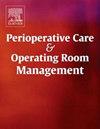通过对新冠肺炎大流行期间手术室学生手部微生物菌群的分析,探讨手术室学生手部卫生意识、信念与表现之间的关系
IF 1
Q2 Nursing
Perioperative Care and Operating Room Management
Pub Date : 2024-12-01
DOI:10.1016/j.pcorm.2024.100430
引用次数: 0
摘要
医务人员遵守手部卫生习惯一直被认为是控制和减少医院获得性感染的有效方法。自2019冠状病毒病大流行爆发以来,手部卫生已成为针对该疾病的有效预防措施之一,引起了人们的认识和关注。本研究旨在通过分析COVID-19大流行期间手术室学生手上的微生物菌群,检查他们对手部卫生的认识、信念和实践。目的是评估学生对手部卫生的遵守程度,这些学生将成为未来的医院员工。目的探讨新型冠状病毒病疫情期间手术室学生手卫生意识、信念及表现与手部微生物菌群的相关性。目的是检查本次大流行期间将成为医院员工的学生对手卫生的遵守情况。方法本研究采用人口普查方法对92名外科专业学生进行调查。数据收集工具包括问卷调查,以评估学生对手卫生的认识、信念和表现,并分析手上的微生物菌群。标准培养基包括血琼脂、亮绿琼脂和伊红亚甲基蓝用于分离微生物。微生物鉴定采用生化试验。结果本组研究对象中,女孩65例,男孩27例,平均年龄21.9±2.3岁。意识、信念和表现的平均得分分别为8.9分、72.3分和64.2分。微生物区系分析也显示,生长最快的微生物是表皮细菌(26.6%)、凝固酶阴性葡萄球菌(22.9%)和链球菌(21.2%)。根据本研究结果,手术室学生在COVID-19大流行期间表现出较高的意识、信念和表现。此外,培养样品中细菌的最小生长证实了这一发现。由于研究的可用性有限,建议在这一领域进行进一步的研究。本文章由计算机程序翻译,如有差异,请以英文原文为准。
Investigating the relationship between awareness, beliefs, and performance of operating room students in hand hygiene with analysis of microbial flora on hands during the COVID-19 pandemic
Background
Hand hygiene compliance among hospital staff has always been recognized as an effective method in controlling and reducing hospital-acquired infections. Since the outbreak of the COVID-19 pandemic, hand hygiene has emerged as one of the effective preventive measures against this disease, leading to increased awareness and concerns. This study aims to examine the awareness, beliefs, and practices of operating room students regarding hand hygiene, by analyzing the microbial flora on their hands during the COVID-19 pandemic. The objective is to assess the level of hand hygiene compliance among students, who will be future hospital employees.
Aim
This study aimed to investigate the correlation between the level of awareness, belief, and performance of operating room students regarding hand hygiene with the analysis of microbial hand flora during the COVID-19 pandemic. The purpose was to examine the compliance with hand hygiene among students, who will be future hospital employees, during this pandemic.
Methodology
The present study included a sample of 92 students majoring in Operating Room who were enrolled in the research through a census. The data collection tool consisted of a questionnaire to assess the students' awareness, beliefs, and performance regarding hand hygiene and analysis of microbial flora on hands. Standard culture media including Blood Agar, Brilliant Green Agar, and Eosin Methylene Blue were used for isolating microorganisms. Microorganism identification was performed using biochemical tests.
Results
The results of this study indicate that out of the participants, 65 were girls and 27 were boys with an average age of 21.9 ± 2.3 years. The mean scores for awareness, belief, and performance were 8.9, 72.3, and 64.2, respectively. Analysis of microbiological flora also revealed that the highest growth microorganisms were epidermidis bacteria (26.6 %), coagulase-negative staphylococci bacteria (22.9 %), and streptococcus bacteria (21.2 %).
Discussion and Conclusion
Based on the results of this study, operating room students have shown a high level of awareness, belief, and performance during the COVID-19 pandemic. Furthermore, the minimal growth of bacteria in the conducted culture samples confirms this finding. Due to the limited availability of studies, it is recommended that further research be conducted in this area.
求助全文
通过发布文献求助,成功后即可免费获取论文全文。
去求助
来源期刊

Perioperative Care and Operating Room Management
Nursing-Medical and Surgical Nursing
CiteScore
1.30
自引率
0.00%
发文量
52
审稿时长
56 days
期刊介绍:
The objective of this new online journal is to serve as a multidisciplinary, peer-reviewed source of information related to the administrative, economic, operational, safety, and quality aspects of the ambulatory and in-patient operating room and interventional procedural processes. The journal will provide high-quality information and research findings on operational and system-based approaches to ensure safe, coordinated, and high-value periprocedural care. With the current focus on value in health care it is essential that there is a venue for researchers to publish articles on quality improvement process initiatives, process flow modeling, information management, efficient design, cost improvement, use of novel technologies, and management.
 求助内容:
求助内容: 应助结果提醒方式:
应助结果提醒方式:


